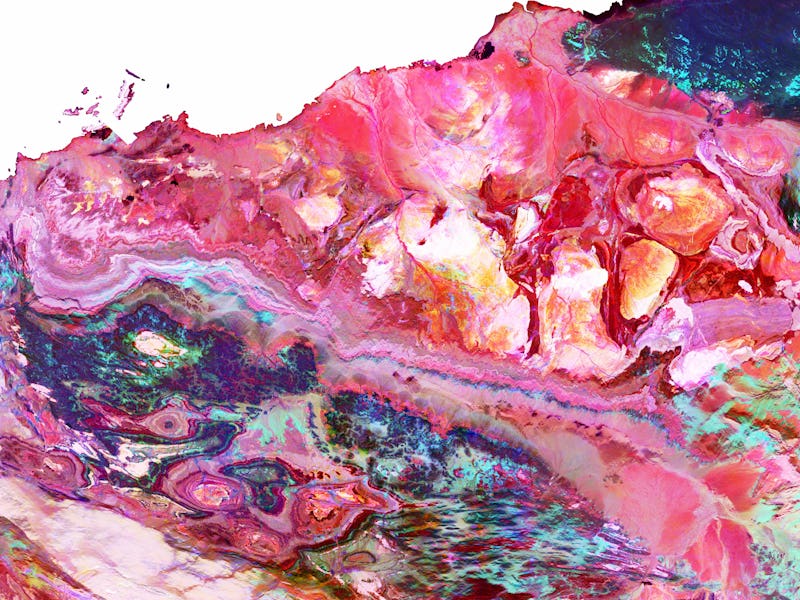Asteroids may have carved Earth's landforms as we know them — study
Ancient asteroids may have shaped landforms on Earth.

For the last decade, metamorphic geologist Tim Johnson at Curtin University in Australia has pondered the first billion years of Earth’s roughly 4.5 billion-year existence.
His work takes him to the edge of rock longevity.
“We’re talking about the time really when the very first rocks started to form, or at least started to be preserved,” he tells Inverse.
That research brought Johnson and his team to a landform in Australia called Pilbara Craton. The iron-rich rocks evaded the conveyor belt system by which archaic most materials atop the planet’s molten materials slid into the depths below to be remixed into new forms. Those rocks held a cosmic secret deep inside.
When scientists looked at Pilbara Craton samples that withstood the geologic odds — they survived as much as 3.6 billion years of tectonic activity — the team found signs that volatile forces scorched submarine crust and triggered continent building. The likely catalysts are asteroids, meaning the asteroids that bombarded a young Earth covered in water and left behind the continents.
Nature published a study that describes what scientists found when they looked at rocks in Western Australia on Wednesday.
This 700-kilometer-wide photo shows the site of the Pilbara Craton in Western Australia.
Here’s the background — Apollo astronauts brought back Moon rocks, and when scientists dated the precious alien parcels, the timescales helped geologists narrow down the age of the Earth but also suggested a secondary aggregation of space stuff, when hefty asteroids clashed with baby Earth roughly 4 billion years ago. This infernal period of time is called the Late Heavy Bombardment.
Since Earth’s tectonic activity has recycled most of the lithosphere — the domain of rocks — teams interested in our planet’s earliest chapters can’t look for craters on Earth from that time like they would on the Moon.
What they did — Johnson and his team looked at the abundance of materials in the samples taken from Pilbara. Hidden deep within the rocks were many clues. First, there was zircon. It’s a common mineral in crustal rocks, “the rocks that form the continents, the things we all sort of walk on,” Johnson says.
He explains that zircon forms tiny mineral grains about the width of a hair, but which are strong and durable. “They can hang around forever, you can do almost anything to them and they’ll just happily plug along. They last a very long time.” Zircon also contains uranium in its structure, which allows geologists to date the hardy rocks when they fire laser beams at these tiny grains to measure the decay of different lead isotopes. “That gives us a chance to look at the history of Earth, by looking at the different ages of zircons,” he says.
The isotopes in rocks also contain oxygen signatures, which tell you if the rocks were born in the deep Earth, or higher up, closer to the atmosphere. The team found that rocks from Pilbara Craton could only be generated if they were borne of basaltic ingredients reacting in shallow seawater when scorched and melted by more than 700 degrees Celsius. “Asteroids would do that,” Johnson says.
Why it matters — This work adds to the conversation about what Earth experienced as a young planet, and how life formed here.
The barrage of asteroids had to be strong enough to bruise and bang the preliminary crust under the seawater, causing the material underneath to swell upwards, and then after numerous cycles of strikes and outpours, finally create the continents.
Volcanos are crucial to making new land, but the continents may have been created by extraterrestrial forces.
But for the hydrothermal processes to exist, this asteroid cannonade had to be significantly milder than the Late Heavy Bombardment.
“What we absolutely do know about the Earth is that, in that first billion years of its existence, it must have been smashed by big meteorites,” Johnson says. The vertical evolution of continental rocks would have happened “towards the end of the so-called late heavy bombardment,” about 3.9 to 3.5 billion years ago according to the study.
What’s next — Johnson’s evidence suggests that asteroids were the culprit, but does acknowledge the slight chance it could have been a super-volcano.
The study authors wrote how their work might expand upon our understanding of life, too: “Life itself may have emerged at around the same time — with water, impact events may be a prerequisite for producing habitable environments in the solar system and beyond.”